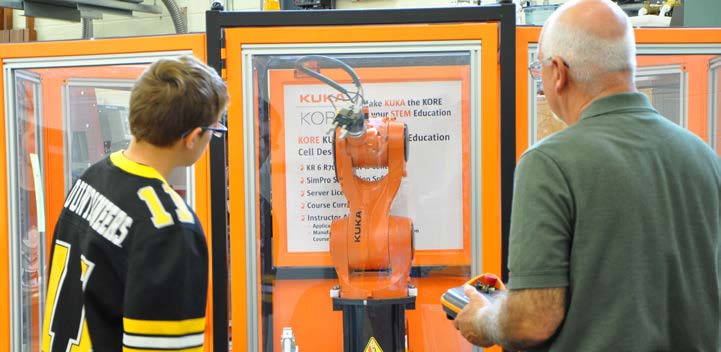Objective:
Organize and coordinate regional economic development by promoting effective land use planning, engaging elected officials and local leaders, sustaining small business, entrepreneurial, and workforce support by leveraging public/private partnerships and investment to unify our economic development narrative and implement best practices.
Competitive Advantage Sustainment Strategic Outline

TACTIC 1
Utilize economic development opportunities to make rural and urban areas hotspots for business.
1.1 Develop new regional partnerships particularly as they pertain to manufacturing and other industries that are crucial to the foundation of the economy.
1.2 Promote collaboration between rural and urban regional partners to elevate market networks.
1.3 Put forth initiatives to encourage green industries within the manufacturing space.

TACTIC 2
Increase skillsets of the regional labor force through the use of targeted training programs.
2.1 Support secondary and post-secondary educational STEM programs.

TACTIC 3
Drive economic advancement and sustainability throughout the Piedmont Triad.
3.1 Cohesively brand and market the region as a destination for new and existing business.
3.2 Make capital investments and resources more accessible for businesses of all sizes.
3.3 Support technological innovations within existing industries and industries that are new to the region.
Measured Impacts
-
-
- Collaborations between rural and urban areas
- Make networks (financial, technical, and physical resources) available to businesses
- Support systems that focus on growing the talent capacity within the labor shed
- Revenue and job growth for key industries
- Number of collaborations between key businesses
- Lower the skills gap for in-demand jobs
-
ENTREPRENEURSHIP STRATEGIC OUTLINE
TACTIC 1
Utilize and promote New Market Tax Credits, Historic Preservation Tax Credits, and regional industrial Opportunity Zones.
TACTIC 2
Ensure proper zoning, special use permits, watershed regulations, resilient building practices, and any other barriers are identified.
TACTIC 3
Develop rural co-working spaces to support rural entrepreneurship.
TACTIC 4
Provide equitable access to mapped out regional assets for entrepreneurial initiatives, funding/investment programs, consulting/mentorship services, working spaces, and other resources.
Measured Impacts
-
-
- Development of and marked co-working entrepreneurial workspaces and facilities.
- Events and marketing outreach geared toward entrepreneur support.
- Expansion of regional capacity for entrepreneurial mentorship, internship, investment ventures, and organized sources for starting a business.
-


GOAL 2 – ESTABLISH AND MODERNIZE A ROBUST REGIONAL INFRASTRUCTURE.
Fostering competitiveness and remaining innovative in the regional, state, national, and global economy requires the Piedmont Triad to revitalize and advocate for improvements to local and state infrastructure as a priority.
Objective:
Promote regional infrastructure that boosts the region’s development needs, especially within broadband availability, cellular coverage, transportation, public utilities, and overall infrastructure that eliminates barriers and provides a sustainable pathway for economic expansion.
DEVELOPMENT INFRASTRUCTURE STRATEGIC OUTLINE

TACTIC 1
Utilize and promote New Market Tax Credits, Historic Preservation Tax Credits, and regional industrial Opportunity Zones.

TACTIC 2
Ensure proper zoning, special use permits, watershed regulations, resilient building practices, and any other barriers are identified.

TACTIC 3
Drive economic advancement and sustainability throughout the Piedmont Triad.
TACTIC 4
Leverage the regional Brownfields Revolving Loan program to encourage sustainable cleanup and repurpose efforts for eligible Brownfield sites.
TACTIC 5
Leverage the regional Brownfields Revolving Loan program to encourage sustainable cleanup and repurpose efforts for eligible Brownfield sites.
Measured Impacts
- Elevated database and use of development and redevelopment sites
- Tactful use of tax credits and finance tools to bolster development
- Increased public and private partnerships regarding site development
- New Market, Tax Increment Financing, historic tax, and other tax credit utilization rate
- Brownfield assessments and cleanups

PUBLIC TRANSPORTATION INFRASTRUCTURE
STRATEGIC OUTLINE
TACTIC 1
Grow transportation options through expanded infrastructure and transportation services.
1.1 Support the expansion of regional and local public transit systems by identifying different funding opportunities at local and state levels.
1.2_Support the development of unified messaging and landing pages with resources to promote existing services across all jurisdictions.
1.3 Research the impact investing in transportation has on local economic development.
1.4 Identify and champion transportation solutions for aging and underserved populations.
1.5 Collaborate on the connectivity of workforce to job sites.
TACTIC 2
Encourage the implementation of alternative fuel and electric vehicles and charging stations.
2.1 Conduct outreach and educational efforts for the community via events and training.
2.2 Maintain a database for the Piedmont Triad that tracks clean transportation options.
BROADBAND STRATEGIC OUTLINE
TACTIC 1
Expand the reach of broadband internet services and speed throughout the region to promote digital equity.
1.1 Build upon and support NC Broadband and Federal initiatives (BAND-NC, GREAT Grant, FCC Broadband Data Collection, Pole Replacement Program, etc.) to combat the digital divide and bring high-speed broadband to all areas in the Piedmont Triad.
1.2 Monitor broadband speeds and access across the region by using and supporting the NC Office of Information and Technology Broadband’s mapping indexes to customize project efforts.
Measured Impacts
- Accurate mapping of broadband speeds across the region.
- Increased technological options throughout the Piedmont Triad.
- Number of households with access to high-speed broadband coverage.
- Wi-Fi accessible and available within more public spaces.


GOAL 3 – CREATE AND CONNECT VIBRANT, HEALTHY, AND RESILIENT COMMUNITIES.
Providing healthy lifestyle and recreation options, a dynamic arts, culture, and entertainment scene, and outstanding education institutions are quality of life attributes driving the desirability to live and stay for Piedmont Triad residents and visitors.
Objective: Protect and improve recreation opportunities, main streets, downtown districts, historic neighborhoods, volume of quality housing for diversified incomes, mixed-use commercial and residential spaces, and destination attraction.
DOWNTOWN RESURGENCE STRATEGIC OUTLINE
TACTIC 1
Solidify the region’s downtowns as the central commercial and social hubs of the community.
1.1 Promote functional and aesthetically pleasing designs that lend themselves to the economic, environmental, and social interests of the region.
1.2 Champion flexible land-use policies/regulations that allow for more diverse and prosperous uses of redevelopment areas and town centers.
1.3 Develop regional strategies to leverage reinvestment by commercial property owners (especially absentee landlords and private investment).
Measured Impacts
- Inventory of development ordinances and regulations that allow a wide variety of options in downtowns or activity centers.
- Provide training on best practices for creating vibrant and disaster resilient communities.
- Re-investment in underutilized properties in the key areas.
Modernization updates to development ordinances. - Designated Main Street Communities.

HEALTHY FOOD CONNECTIONS STRATEGIC OUTLINE
TACTIC 1
Facilitate a regional food network system with local suppliers to encourage participation market leverage.
1.1 Work with buyers, chefs, restaurant associations, healthcare partners, educational institutions, and other such groups to determine the demand for specific products, in order to better inform/connect producers with opportunities.
1.2 Explore the possibility of establishing region-wide distribution systems to support the transportation of fresh produce across the region.
1.3 Support programs that provide processing capacity for food and meat producers that are too small to serve commodity markets, but too large to sell directly to consumers.
1.4_Connect local farmers and food producers to the region’s network of agricultural research centers and professionals.
1.5_Serve as a leader for diversity, equity, and inclusion in all local food initiatives by providing training, resources, and guidance to local agencies.
TACTIC 2
Establish food policy councils in each county to assess co-ops, collectives, supply chain development, and agritourism.
2.1 Ensure broad levels of participation including multiple sectors of the food system such as schools, nonprofits, farmers, recycling, and waste organizations.
2.2 Facilitate meaningful cooperation among local food councils and grassroots organizations to maximize impact and improve the local food economy.
2.3 Support the creation of new markets across the region via farmer’s markets and innovative approaches to the local food supply chain.
Measured Impacts
- Target areas of improvement, investment, and opportunity.
- Collaboration among Triad food policy councils and food stakeholders.
- Significant data collection completed in partnership with local agencies to support long-term data and metrics about the regional food system.
- Increase the number of collaborative projects undertaken each year with the local food council and advocacy.
- Local food production and sales output.
- Job growth in the food and beverage industry.
- Increased number of partnerships formed between producers and potential markets.
- Leveraged resources to support additional value being put on food production.
- Number of training, resources, and/or guidance conversations with local agencies to increase equity in the food system.
AFFORDABLE HOUSING STRATEGIC OUTLINE
TACTIC 1
Diversify and inflate the affordable housing stock in areas near employment centers, public transportation access, and existing infrastructure.
1.1 Join with State efforts to develop a state-wide housing strategy aimed at improving affordable renter and owner-occupied housing stock for workers and families living in rural and downtown settings.
1.2 Coordinate existing housing programs and financial incentives to include best practices in affordable housing investments.
Measured Impacts
-
Inventory of regional housing stock conditions including age, etc. The amount of housing stock that is affordable to workers making 120% or less of the average wage.
Invest in the rehabilitation of affordable housing supply to improve living conditions and health outcomes. -
The amount of housing stock that is affordable to workers making 120% or less of the average wage.
-
Defined best practices and administration of housing authorities.
EFFECTIVE LAND USE STRATEGIC OUTLINE
TACTIC 1
Encourage the efficient and resilient use of land resources.
1.1 Foster the assessment, cleanup, and redevelopment of old commercial/industrial sites.
1.2 Promote smart growth methods when constructing new sites for future redevelopment.
1.3 Pursue growth policies and regulations to support the efficient use of existing water, sewer, and transportation infrastructure.
1.4 Encourage infrastructure design/plans to support sustainable, resilient community development patterns and help reduce the negative impacts of climate change.
1.5 Use regional programs to support efficient transportation, land use, and planning.
Measured Impacts
-
Complete a community engagement strategy geared towards building engagement capacity at the community and municipal levels.
-
Use local, county or regional hazard mitigation plans to guide disaster resilient communities.
-
Shared-use agreements and policies in place for community facilities.
-
Number of bicycle share programs.
-
Public-private partnerships for community engagement.
-
Increased civic participation of underserved communities in surveys, public meetings, and events.
-
Reduce the time needed for communities to access resources and recover from disasters.

GOAL 4 – DEVELOP AND RETAIN TALENTED AND INNOVATIVE HUMAN CAPITAL.
Investing in public and private educational training partnerships that cultivate a flexible, entrepreneurial-minded, globally-oriented, and diversified workforce is the most essential component for regional economic development and overall competitiveness. Nourishing and evolving the workforce with crosscutting competencies sought by employers, ensure needs of a growing and adaptive economy are holistically met.
Objective: Invigorate collaboration between private industry clusters, higher education institutions, and K-12 education, especially career technical education (CTE) to increase workforce participation by reducing barriers, CTE enrollment, and better alignment of training with in-demand skills to close the skills gap and foster growth.
WORK INITIATIVES STRATEGIC OUTLINE

TACTIC 1
Ignite workforce initiatives designed to help individuals complete training/educational programs that grant in-demand skills for the versatile job market.
1.1 Create, deliver, and support new regional initiatives that align job-skill requirements with training curricula.
1.2 Heighten awareness and access to online degree completion and all online job training programs.
1.3 Solidify and highlight career pathways within programs such as advanced manufacturing, technology, healthcare, aviation, logistics, and creative industries.
1.4 Improve mentoring programs for increased training-to-work efforts.

TACTIC 2
Identify opportunities to assist adult workers with the unique challenges they face while seeking a change in career.
2.1 Support veterans leaving the military in their search to find jobs in the Piedmont Triad.

TACTIC 3
Work to eliminate workforce barriers that limit participation such as transportation, childcare, and housing.
Measured Impacts
-
Successful implementation of new training initiatives and growth of existing initiatives.
-
Completion of training programs aligning with the needs of the workforce.
-
Increase in the number of veterans employed.
-
Public-Private partnerships developing job skills training opportunities and community investment.
-
Identify and address workforce barriers within transportation, childcare, and housing.

K-12 EDUCATION AND YOUTH LEADERSHIP STRATEGIC OUTLINE
TACTIC 1
Promote K-12 education that focuses on technology
and real-world application.
1.1 Facilitate the connection between careers and high schools for internships, apprenticeships, and post-high school job opportunities.
1.2 Promote the growth of youth-related entrepreneurship organizations.
1.3 Support the implementation and marketing of entrepreneurial education, and career technical education programs, and higher education preparation courses.

1.4 Connect high school business students to small business owners through entrepreneurship education and mentorship programs.
Measured Impacts
-
Successful collaboration of high schools with regional industries and businesses.
-
Monitoring drop-outs rates and the career pathways students are participating in.
